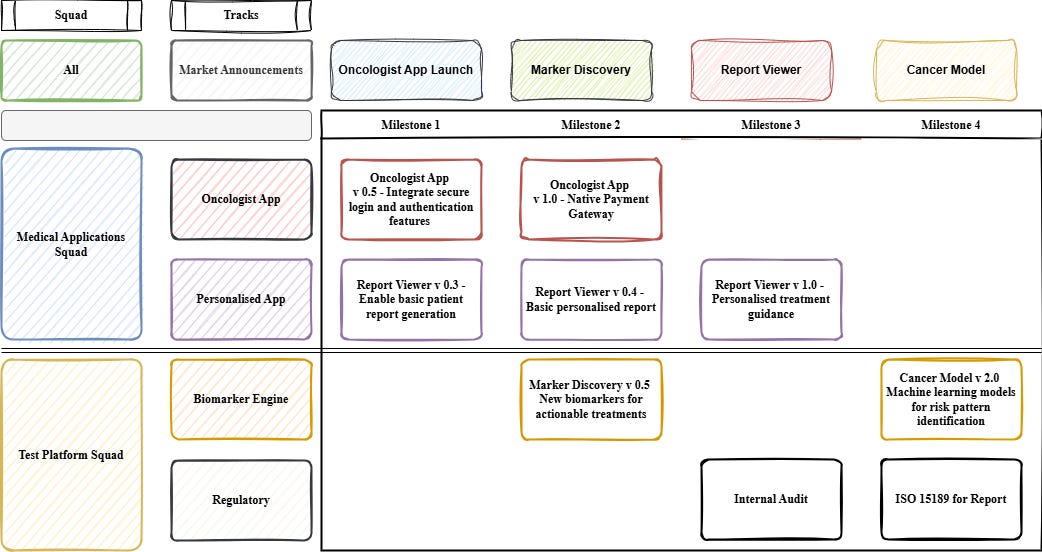Unified Roadmaps Across Squads
Leveraging a Unified Product Roadmap for Cross-Squad Alignment
Product squads are designed to operate independently, each developing their own vision, OKRs, and roadmap. While this autonomy fosters innovation, it can lead squads to become too insular, resulting in blockers due to cross-squad dependencies. Without visibility into other squads' plans, teams may find themselves waiting on deliverables from others, causing delays and misalignment.
A unified product roadmap can address these cross-squad dependencies by providing transparency about when deliverables are scheduled, allowing squads to align their plans accordingly. It ensures that all teams are moving in the same direction and are aware of each other's timelines and dependencies.
Setting Up a Unified Roadmap

Creating a unified roadmap is a straightforward process:
Consolidate Squad Roadmaps
Each squad places their streams and tracks into a single document or platform. Streams and tracks represent the major initiatives or components within each squad's scope.
Standardise Milestone Descriptions
Each milestone is written as a headline feature that succinctly summarises the deliverable. These should be crafted like press release headlines so that product marketing can easily repurpose them for external communications, such as blog articles or marketing releases.
Visualise Milestones on a Timeline
By sequencing the milestones along a timeline (the x-axis), squads can align the order of deliverables and identify where they may be blocked due to dependencies on other squads. This visual alignment helps teams understand how their work fits into the broader product development schedule.
Maintain Consistent Timeframes
Each milestone represents a vertical slice of work intended to be delivered in a six-week period. This consistent sizing allows squads to estimate delivery timeframes more accurately and align milestones effectively. Six weeks is optimal—long enough to accomplish meaningful work but short enough to maintain momentum.
Benefits of a Unified Roadmap
The squads now have up-to-date and transparent information on what other squads are currently working on. This arms them with the information to engage on a squad-to-squad level to workshop how to unblock deliverables.
Another benefit of aligning the roadmaps in one document is providing a top-line summary of the major deliverables. These could be significant initiatives that internal stakeholders are eager to know about or market-moving deliverables that will impact revenue. This unified roadmap allows executives to understand, at a quick glance, key deliverables, serving as an effective stakeholder management tool. It not only aids in strategic decision-making but also ensures that all levels of the organisation are aligned with the company's objectives.
The unified roadmap also facilitates marketing and go-to-market planning. The top-level highlights can form the basis for product marketing activity as part of the launch strategy for major initiatives. Since milestones are written like press release headlines, they are readily usable by marketing teams for external communications, ensuring consistency in messaging and branding.
Additionally, the roadmap provides accessible detailed information without overwhelming stakeholders. Each milestone can hyperlink to its Product Requirements Document (PRD), allowing interested parties to delve into the specifics as needed. This approach balances the need for high-level overviews with the availability of detailed insights, catering to a diverse audience with varying informational needs.
Conclusion
By adopting a unified product roadmap, organisations can transform autonomy into aligned innovation. Squads retain their independence and creativity but now have the transparency and coordination needed to work cohesively towards shared goals. This strategic approach improves collaboration, drives efficiency across product squads, and ultimately leads to better product quality and timely delivery.

